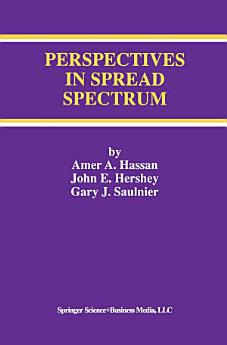Perspectives in Spread Spectrum
Dec 2012 · The Springer International Series in Engineering and Computer Science Book 459 · Springer Science & Business Media
4.0star
2 reviewsreport
Ebook
163
Pages
reportRatings and reviews aren’t verified Learn More
About this ebook
Perspectives in Spread Spectrum brings together studies and recent work on six exciting topics from the spread spectrum arts. The book gives a wide, collective view of trends, ideas, and techniques in the spread spectrum discipline, due to the authors' extensive work on spread spectrum techniques and applications from different vantage points. The inexorable march of electronics towards ever faster, ever smaller, and ever more powerful electronic and optical circuitry has wrought, and will continue to enable, profound changes in the spread spectrum arts, by allowing increasingly complex signalling waveforms and statistical tests to be implemented as the theory beyond spread spectrum continues to evolve.
Perspectives in Spread Spectrum is divided into six chapters. The first chapter deals with sequence spreading design. There is not a single metric for design of spreading sequences; rather, the design is ideally tailored to the specific scenario of usage. This chapter delves into recent and very promising synthesis work. The second chapter deals with OFDM techniques. As channels become wider and trans-channel fading (or jamming) becomes frequency selective across the band, OFDM techniques may provide a powerful alternative design perspective. The third chapter is a generalization of the venerable Walsh functions. A new modulation scheme, Geometric Harmonic Modulation, GHM for short, is reviewed and characterized as a form of OFDM. From GHM, a further generalization of the Walsh functions is derived for non-binary signalling. The fourth chapter is concerned with some new and exciting results regarding the follower jammer paradigm. A counter-countermeasure technique is reviewed, notable for its counterintuitive characteristic which can be understood from a simple yet elegant game framework. The fifth chapter recounts some results pertaining to random coding for an optical spread spectrum link. The technique is based on laser speckle statistics and uses a coherent array of spatial light modulators at the transmitter but allows the receiver to be realized as a spatially distributed radiometric and therefore incoherent structure. The sixth and final chapter looks at an important and interesting application of spread spectrum to accurately locate a wideband, ‘bent pipe’, satellite transponder. It is, in a strong sense, an inverted GPS technique.
Perspectives in Spread Spectrum serves as an excellent reference and source of ideas for further research, and may be used as a text for advanced courses on the topic.
Perspectives in Spread Spectrum is divided into six chapters. The first chapter deals with sequence spreading design. There is not a single metric for design of spreading sequences; rather, the design is ideally tailored to the specific scenario of usage. This chapter delves into recent and very promising synthesis work. The second chapter deals with OFDM techniques. As channels become wider and trans-channel fading (or jamming) becomes frequency selective across the band, OFDM techniques may provide a powerful alternative design perspective. The third chapter is a generalization of the venerable Walsh functions. A new modulation scheme, Geometric Harmonic Modulation, GHM for short, is reviewed and characterized as a form of OFDM. From GHM, a further generalization of the Walsh functions is derived for non-binary signalling. The fourth chapter is concerned with some new and exciting results regarding the follower jammer paradigm. A counter-countermeasure technique is reviewed, notable for its counterintuitive characteristic which can be understood from a simple yet elegant game framework. The fifth chapter recounts some results pertaining to random coding for an optical spread spectrum link. The technique is based on laser speckle statistics and uses a coherent array of spatial light modulators at the transmitter but allows the receiver to be realized as a spatially distributed radiometric and therefore incoherent structure. The sixth and final chapter looks at an important and interesting application of spread spectrum to accurately locate a wideband, ‘bent pipe’, satellite transponder. It is, in a strong sense, an inverted GPS technique.
Perspectives in Spread Spectrum serves as an excellent reference and source of ideas for further research, and may be used as a text for advanced courses on the topic.
Ratings and reviews
4.0
2 reviews
Anil Das
- Flag inappropriate
December 6, 2020
AAA
Rate this ebook
Tell us what you think.
Reading information
Smartphones and tablets
Install the Google Play Books app for Android and iPad/iPhone. It syncs automatically with your account and allows you to read online or offline wherever you are.
Laptops and computers
You can listen to audiobooks purchased on Google Play using your computer's web browser.
eReaders and other devices
To read on e-ink devices like Kobo eReaders, you'll need to download a file and transfer it to your device. Follow the detailed Help Center instructions to transfer the files to supported eReaders.









